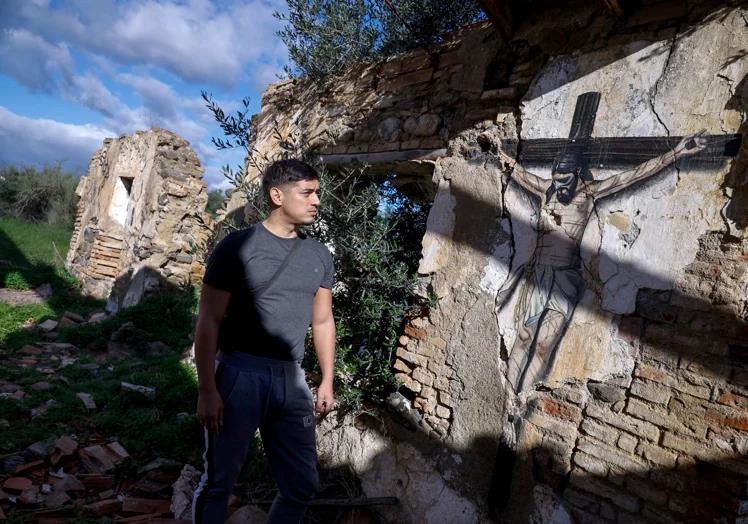

Sections
Highlight

For a year and a half the image of Christ on the cross has been presiding over these ruins in the Axarquia area of Malaga province, converting it into an improvised altar. There is a dried bouquet of flowers, small cardboard votives of the Virgin crumpled on the floor and papers on which it is obvious that someone had written something. The 'Cristo del Amor' (Christ of Love) by Julio Anaya, an work of art commissioned by the local religious Hermandad del Amor brotherhood to celebrate its centenary, went from being something quite secret to having its own label on Google Maps with the description of 'religious destination'. During this time some graffiti has appeared around it, but the image of Christ on the Cross had always been respected. Until now. The Christ of Love was vandalised this Christmas, the news posted on social media the same day it was discovered with Christ's face completely painted over and a swastika on the body. Julio Anaya's reaction was immediate. "If there are people who want to destroy the work, as long as I can I will restore it."
He is not willing to let it stay desecrated. As an urban artist who for years has recreated the work of the great masters on crumbling walls, Anaya is aware that his art is fleeting and that the wear and tear that continues is part of its beauty. "I am also vandalising in a way by painting in public spaces. I know what I'm playing at, I understand the ephemeral nature of my work, it's what I value and what makes sense in my artistic installations." However, this is something else.

Something surprising happened with this painting. If his work consists of "desacralising" (to desanctify) classic paintings from the art world by removing them from the protection of museums, painting them in the open air or on pieces of cardboard saved from the rubbish tip, the opposite has happened here. Julio Anaya took a religious work from its home, its temple, and the effect was reversed- in summary, "the image sacralised [made holy] a place that was abandoned." This place in the Axarquía, which is accessed by a dirt track running through an olive grove, is today a place of pilgrimage. "It's incredible, I was flipping out in my head. It has been the people who have completed the piece by coming here and taking it as a focal point. It's beautiful."
Julio Anaya said these words in front of the Christ of Love just a few days ago, when we returned with him to the ruins to cover a story that he had planned to publish around this time and which will no longer be published as planned. That day, the man from Malaga observed the piece carefully. He saw it had deteriorated, with a few more chips and duller colours. "It is inevitable, but it is shocking to see this image like this, with how well they take care of them in the churches (...) It is strange because these types of art works are eternal because of the care and effort we take, and to see them devoid of this care and protection also seems beautiful to me."
At that time he was not thinking of restoring it, joking that he might do so in a couple of years while keeping everyone in the dark. But the message he received during Christmas lunch from the elder brother of the Hermandad, Álvaro Guardiola, has brought everything forward. He always says goodbye to his urban art pieces when he finishes them and he photographs them. "But this one has been so special and so beautifully received in this community that it bothers me, even more for them than for me." Moreover, he is indignant about the symbol and the date chosen, because he would understand any other scribble or graffiti. It's the street. But not this. "It's done out of malice."
The brotherhood confirms that the trickle of people to the place is constant. "There are even brothers who have had their children's first communion photos taken there", said Guardiola. But a positive reading can also be made of the negative news of this vandalism: "The Christ of Love must be having some influence from there when there are people who want to destroy it, something must be confronting them and touching their inner self."
Anaya will now look for a gap in his international work and exhibition schedule to restore the image to its original state. He has no time to spare. Until a few days ago some of his work was in a collective exhibition in Tokyo dedicated to Godzilla and organised by Nanzuka Underground. He participated with a recreation of the monster in cardboard and, for the first time, with a canvas done his own way. Julio Anaya painted a classic landscape on a conventional framed canvas and then smashed it to pieces with a sledgehammer. "It's like rescuing a piece from a museum that has been razed to the ground by Godzilla in the city of Tokyo," he said.
It won't just be a one-off. "I want to continue making these pieces but on a larger scale." In fact, he has sent a couple more of these pieces to Japan for a travelling exhibition that has just opened. For next year it is already known that more of his work will be at ARCO, Art Basel Hong Kong, Art Basel Brussels and at the Fundación Casa Natal de Picasso in Malaga, where he will 'deconstruct' his version of Picasso's Guernica in cardboard to adapt it to the narrow dimensions of the space.
Publicidad
Publicidad
Publicidad
Publicidad
Esta funcionalidad es exclusiva para suscriptores.
Reporta un error en esta noticia
Comentar es una ventaja exclusiva para registrados
¿Ya eres registrado?
Inicia sesiónNecesitas ser suscriptor para poder votar.